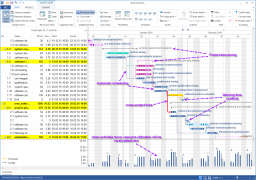Project Planning: Scheduling & Estimating Activity Duration
by David Kohanbash on September 6, 2023

Successful projects tend to have schedules that work (as well as budget, but that is for another time). This schedule should be made at the start of the project and actively maintained throughout the project. On large projects this may mean having a dedicated person to maintain and track the schedule.
I would generally recommend revisiting the schedule at least once a month. On fast moving projects before a deadline, the schedule might need to be updated daily. When looking at the schedule it is important to note what the critical path items are, as well as the items that are approaching becoming critical path. The critical path tells you what items must happen on time for the project to continue on schedule and not have a delay.
Good team activity and communication is especially important at the start of a project to make sure all tasks are captured and sequenced properly so that the schedule is accurate.
Building Your Schedule
There are two primary ways to build your schedule, and then you can also mix them together.
Bottom Up: The bottom up approach says to look at each individual task and estimate how long it will take to complete that task. Then all of the tasks are lined up to figure out when the project will be complete.
Top Down: The top down approach looks when the project needs to be completed by, and then starts back filling the tasks from that due date to figure out how long you have to complete each task.
In the real world we often mix the two approaches together to massage the schedule until it works and meets the project requirements. When doing this task it is important to be realistic and not just make the project look possible on paper. There are various ways to fix a schedule to be accurate that we will look at later.
Estimating Task Duration
When estimating task duration there are two primary ways to determine how long a task will take.
- Based on historical data for the task
- Making an “expert” guess at how long the task will take
We all know that time estimates are likely incorrect. The Navy developed the Program Evaluation and Review Technique (PERT) method in the 1950s to try and account for this estimation error.
Estimated_Task_Duration = (Optimistic_Estimate + 4 x Most_Likely_Estimate + Pessimistic_Estimate) / 6
Or in short form:
E = (O + 4L + P) / 6
E: Estimate
O: Optimistic
L: Most Likely
P: Pessimistic
This approach gives a weighted average giving the most likely (L) estimate a four times advantage. This gives a better estimate than just using the most likely estimate. This is especially true when you start stacking many tasks together in the same schedule.
Schedule Mitigation Strategies
You just finished building the schedule and tasks are not lining up for the project to end on time. First, Breath (this is very common). Second, lets look at some of the strategies below.
Scope Reduction: Do less, remove the “nice to haves”. Sometimes you need to step back and look at what are the actual requirements and what tasks can be removed. In the startup world this is also called developing the Minimal Viable Product (MVP), essentially remove the fat so the overall project will succeed.
Fast Tracking: Do things in parallel. Are there any tasks that can be done at the same time to speed up the overall process. This is a time when the regular flow of a project can often be modified in exchange for increased risk. For example instead of proving if a method is possible, you just start developing something assuming that it will be possible. Or you start designing an enclosure before the circuit board inside is complete.
Crashing: This is where you add more resources (people, money, etc..) to the project. Sometimes you just need more help. This can take the form of hiring more people/contractors to help, sending parts out to multiple machine shops, paying machine shops to put your parts at the front of the line, etc…
Hopefully the above methods will help you schedule your next project better and make the project successful.
Featured Image source: https://upload.wikimedia.org/wikipedia/commons/7/7c/Rillsoft-multi-project-gantt-chart.png


Leave a Reply